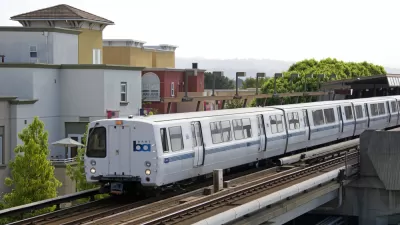With 27 transit agencies, traveling across the Bay Area can be a daunting task. Advocates for 'seamless transit' want to change that.

A blog post from TransitCenter explains the San Francisco Bay Area's complicated transit system, which boasts 27 different agencies across nine counties.
The introduction of the Clipper Card in 2002 was intended to help. For the first time, riders could use the same payment card for rides across the region. But the technology alone wasn’t enough to solve the problem. To this day, riders whose trips require them to use multiple agencies still face a penalty – interagency transfers are only sparingly accepted, and most agencies don’t coordinate their schedules, creating long waits between transfers.
Thanks in part to advocacy from a group calling itself Seamless Bay Area, a proposed state bill dubbed the "Seamless Transit Transformation Act" would mandate an integrated fare structure by 2024 and require transit agencies to coordinate schedules, service, and maps in order to receive state funding. "With the Bay Area’s infamous housing costs continuing to push people further from employment centers and ridership slow to recover from the pandemic, the initiative could be the key to bringing back riders, and making transit a viable option for tens of thousands more people," the blog states.
"There have been various attempts at fare integration over the last several decades, but the efforts haven’t been resourced or coordinated enough to be successful." To find out why, "According to [Seamless’s Advocacy Director, Adina Levin], Seamless looked at where previous integration efforts had fallen short, and brought in equity-focused groups and elected officials to the task force process and accompanying outreach in order to increase the likelihood of success." The organization has focused on developing a plan to integrate the dozens of agencies under one umbrella, with questions of logistics and revenue share still to be decided.
FULL STORY: Towards a Seamless Bay Area

Alabama: Trump Terminates Settlements for Black Communities Harmed By Raw Sewage
Trump deemed the landmark civil rights agreement “illegal DEI and environmental justice policy.”

Study: Maui’s Plan to Convert Vacation Rentals to Long-Term Housing Could Cause Nearly $1 Billion Economic Loss
The plan would reduce visitor accommodation by 25% resulting in 1,900 jobs lost.

Planetizen Federal Action Tracker
A weekly monitor of how Trump’s orders and actions are impacting planners and planning in America.

Wind Energy on the Rise Despite Federal Policy Reversal
The Trump administration is revoking federal support for renewable energy, but demand for new projects continues unabated.

Passengers Flock to Caltrain After Electrification
The new electric trains are running faster and more reliably, leading to strong ridership growth on the Bay Area rail system.

Texas Churches Rally Behind ‘Yes in God’s Back Yard’ Legislation
Religious leaders want the state to reduce zoning regulations to streamline leasing church-owned land to housing developers.
Urban Design for Planners 1: Software Tools
This six-course series explores essential urban design concepts using open source software and equips planners with the tools they need to participate fully in the urban design process.
Planning for Universal Design
Learn the tools for implementing Universal Design in planning regulations.
Caltrans
Smith Gee Studio
Institute for Housing and Urban Development Studies (IHS)
City of Grandview
Harvard GSD Executive Education
Toledo-Lucas County Plan Commissions
Salt Lake City
NYU Wagner Graduate School of Public Service





























